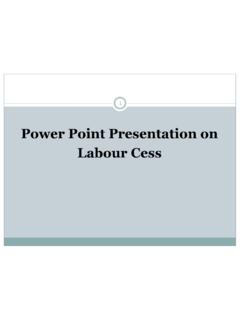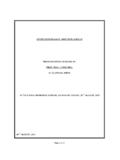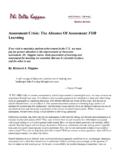Transcription of APMC TALLY SCRN FOR TRAINING - MACP
1 TRAINING MATERIAL & TALLY MODEL COMPANY 1 INDEX SR NO. PARTICULARS PAGE NO. 1 Basic Principles of Accounting 2 4 2 Golden Rules of Accounting 5 5 3 First Screen 6 6 4 Select Company 7 7 5 Choose Company 8 8 6 Gateway of TALLY 9 9 7 Change in Accounting Period 10 10 8 Alter/Create New Company 11 11 9 Recording of Opening Balances 12 15 10 Making Accounting Entries 16 16 11 Select the Proper Key As per Requirement 17 17 12 F6 Receipt Entries 18 19 13 F4 Contra Entries 20 21 14 F5 Payment Entries 22 23 15 Banks Monthly Extracts 24 24 16 Banking Detailed Transactions 25 25 17 Preparing Bank Reconciliation Statements 26 26 18 Printing Option 27 28 19 Trail Balance View 29 33 20 Profit &
2 Loss A/c View 34 34 21 Balance Sheet view 35 35 22 Shortcut Keys in TALLY 36 - 38 2 Basic Principles of Accounting : - Guidelines on Basic Accounting Principles and Concepts GAAP (Generally Accepted Accounting Principles) is the framework, rules and guidelines of the financial accounting profession with a purpose of standardizing the accounting concepts, principles and procedures. Here are the basic accounting principles and concepts under this framework : 1. Business Entity A business is considered a separate entity from the owner(s) and should be treated separately. Any personal transactions of its owner should not be recorded in the business accounting book, vice versa.
3 Unless the owner s personal transaction involves adding and/or withdrawing resources from the business. 2. Going Concern It assumes that an entity will continue to operate indefinitely. In this basis, assets are recorded based on their original cost and not on market value. Assets are assumed to be used for an indefinite period of time and not intended to be sold immediately. 3. Monetary Unit The business financial transactions recorded and reported should be in monetary unit, such as INR,US Dollar, Canadian Dollar, Euro, etc. Thus, any non-financial or non-monetary information that cannot be measured in a monetary unit are not recorded in the accounting books, but instead, a memorandum will be used.
4 3 4. Historical Cost All business resources acquired should be valued and recorded based on the actual cash equivalent or original cost of acquisition, not the prevailing market value or future value. Exception to the rule is when the business is in the process of closure and liquidation. 5. Matching Concept This principle requires that revenue recorded, in a given accounting period, should have an equivalent expense recorded, in order to show the true profit of the business. 6. Accounting Period This principle entails a business to complete the whole accounting process of a business over a specific operating time period.
5 It may be monthly, quarterly or annually. For annual accounting period, it may follow a Calendar or Fiscal Year. 7. Conservatism This principle states that given two options in the valuation of business transactions, the amount recorded should be the lower rather than the higher value. 8. Consistency This principle ensures consistency in the accounting procedures used by the business entity from one accounting period to the next. It allows fair comparison of financial information between two accounting periods. 4 9. Materiality Ideally, business transactions that may affect the decision of a user of financial information are considered important or material, thus, must be reported properly.
6 This principle allows errors or violations of accounting valuation involving immaterial and small amount of recorded business transaction. 10. Objectivity This principle requires recorded business transactions should have some form of impartial supporting evidence or documentation. Also, it entails that bookkeeping and financial recording should be performed with independence, that s free of bias and prejudice. 5 Golden Rules of Accounting :- A] Real Accounts:- 1)Debit what comes in. 2)Credit what goes out. B] Personal Accounts :- 1)Debit the reciver. 2)Credit the giver. C] Nominal Accounts :- 1)Debit all expenses & Losses.
7 2)Credit all Incomes & Revenue. FIRST SCREEN :- TALLY ERP Icon. Please double Click on TALLY ERP9 Icon or select and press enter on TALLY ERP9 Icon to start the TALLY ERP Program SELECT COMPANY:- Main Screen Enter on Select or Press S to open the desired company. CHOOSE COMPANY :- Choose the Relevant company from the list and press enter. GATEWAY OF TALLY :- At this screen, it can be seen as to which company is open, period of operation, current date and the date of last entry. CHANGE ACCOUNTING PERIOD :- Press Alt-F2 to change the period for which accounting is to be done. ALTER COMPANY/ CREATE NEW COMPANY :- After pressing Alt-F3 , the company info screen is displayed, in which options for Altering company master data, backup etc are seen (Alter).
8 RECORDING OF OPENING BALANCES :- PATH : At Gateway of TALLY Accounts Info Ledger Alter Cash in Hand. The opening Balances of all Balance Sheet items can be recorded by selecting the ledgers. ENTER THE OPENING BALANCE AMOUNT :- The Opening Balance as on 01-04-2013 can be feeded for all ledgers and it should be ensured that there is no difference in opening Balance in TALLY . PATH : Accounts info Ledger Alter DCC BANK ENTERING THE OPENING BALANCE AMOUNT :- The Closing balance as on as per audited statement of accounts can be recorded as opening balance as on FOR MAKING ACCOUNTING ENTRIES :- Select Accounting Vouchers 17 SELECT THE PROPER KEY AS PER REQUIREMENT :- i) F4 Contra : For any Deposit/Withdrawal of Cash from Bank.
9 (Only Cash/Bank A/c are Debited / Credited in Contra entries.) ii) F5 Payment: For any Payment made weather cash /Cheque entry should be passed through Payment entry. (Only Cash/Bank A/c are Credited in Payment entry.) iii) F6 Receipt: For any Receipt weather in cash /Cheque entry should be passed through Receipt entry. (Only Cash/Bank A/c are Debited in receipt entry.) iv) F7 Journal : Other than Cash/Bank any entry can be passed through Journal entry. (Transactions where No Cash/Bank A/c are affected should be passed through Journal Year end Provisions entries). v) F8 & F9 Sales & Purchase Entries: For Trading Activities Purchase & Sales of Goods, Entries should be passed through this keys.
10 SELECT F6 KEY FOR RECEIPT ENTRY : - MAIN MARKET FEES RECEIPT. For recording of any transactions, Rules of Accounting should be followed. At the time of recording Market receipt (Income) Nominal Accounts rules Credit the Incomes and Revenues.( Please refer above screen). Summary of Transactions Should be mentioned in Narration Part. In the above entry, please provide the details of Cheque Number, Name of the Bank, Branch etc which will facilitate Bank Reconciliation. SUB MARKET FEES RECEIPT. In the above entry , please provide the details of Cheque Number, Name of the Bank, Branch etc which will facilitate Bank Reconciliation.









